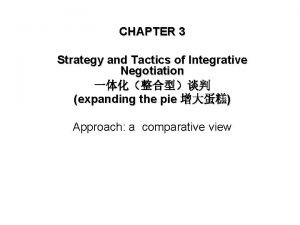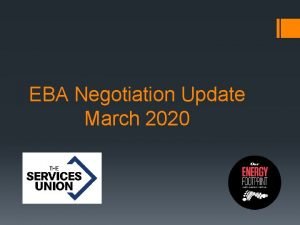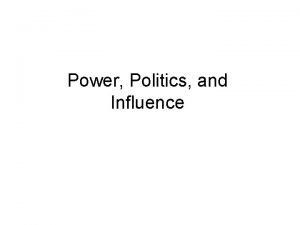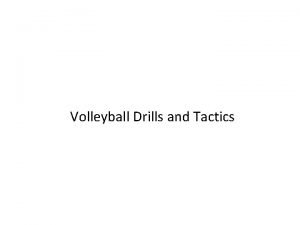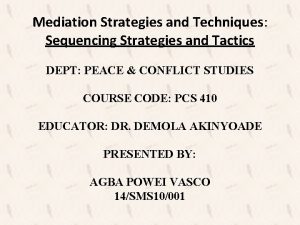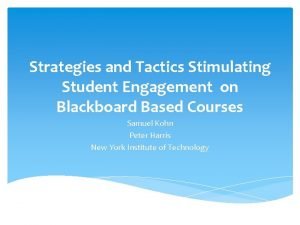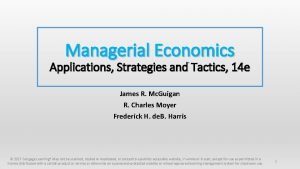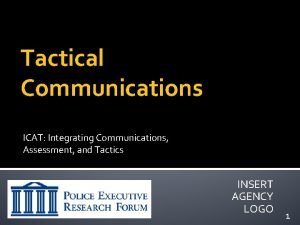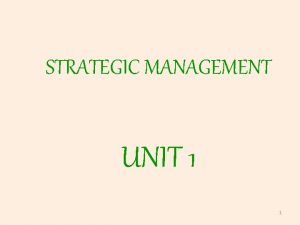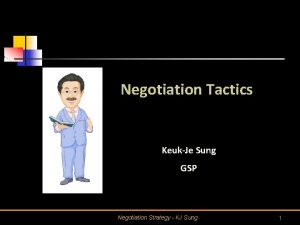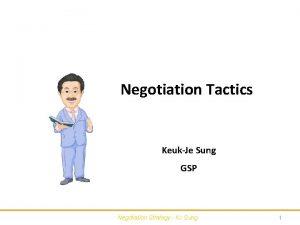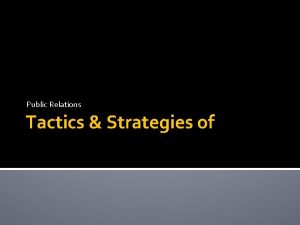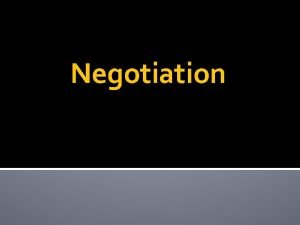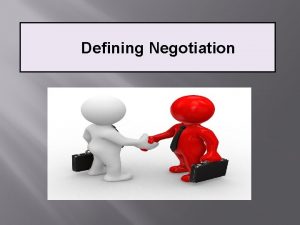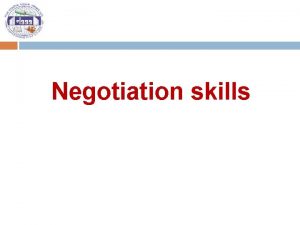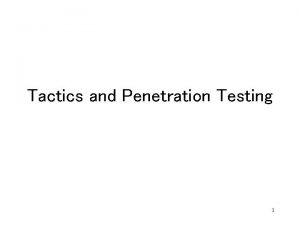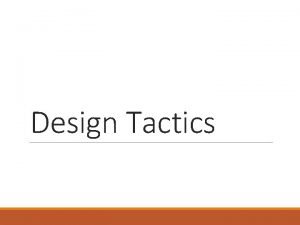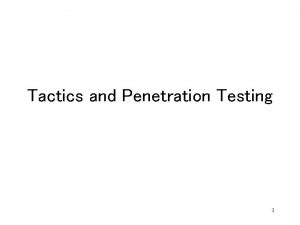Negotiation Strategies and Tactics Evolution of Negotiation A















- Slides: 15

Negotiation Strategies and Tactics

Evolution of Negotiation “A Plan for Success” n Give and Take Dr. Chester Karrass n Getting to Yes Fisher and Ury n Difficult Conversations Stone, Patton and Heen 6. 7_2

Give and Take “Power Tactics” Guidelines n n n n n Original Negotiation Encyclopedia Power Assessment Negotiation Traits Planning Negotiation Modes Buyer/Seller Satisfaction Tactics and Countermeasures Aspiration Level Concessions Messages n n n Understand Your Sources of Power Planning Pays Off Profit is a Gain in Satisfaction Aim Higher - You Come Out Better Always Make Assumptions, but. . . Change the Time and Shape of the Money 6. 7_3

Getting to Yes “Joint Problem Solving” Guidelines n n n Focus on Common Interests, not Differing Positions Invent Options for Mutual Gain Use Power of Independent Standards Always Develop your BATNA Separate the People from the Problems Messages n n n Negotiation is Like Playing Frisbee Convert Age of Me to Era of We Key is Mutually Acceptable Conflict Resolution Try Side-by-Side Problem Solving There is Always a Better Deal for Both Parties Learn How to be a Fly on the Wall 6. 7_4

Getting to Yes “Change the Game” Problem Solution Positional Bargaining: Which Game Should You Play? Change the Game-Negotiate on the Merits 6. 7_5

Difficult Conversations “Create a Learning Conversation” Guidelines n n n Sort Out Three Conversations The “What Happened” Conversation The “Feelings” Conversation The “Identity” Conversation Shift to a Learning Stance, a Learning Conversation Sincere Listening Works (Help Me Understand) Open with Self Confident Expression Begin with the Third Story (Your Story, Other Person’s Story, and the Invisible Third Story) Messages n n n n n Explore Each Other’s Stories Learn to be Curious Abandon Blame Map the Contribution System Feelings Matter Acknowledge Feelings Ground Your Identity. . . Ask Yourself What’s at Stake Manage Your Internal Voice Join Together as partners, Sort Out the Situation Together 6. 7_6

Difficult Conversations “How to Discuss What Matters Most” The “What Happened? ” Conversation Challenge: The Situation is more complex than either person can see. A Battle of Messages A Learning Conversation Assumption: I know all I need to know to understand what happened Assumption: Each of us is bringing different information and perceptions to the table. There are likely to be important things that each of us doesn’t know. Goal: Persuade them I’m right. Goal: Explore each other’s stories: how we understand the situation and why. Assumption: I know what they intended. Assumption: I know what I intended, and the impact their actions had on me. I don’t and can’t know what’s in their head. Goal: Let them know what they did was wrong. Assumption: It’s all their fault. (Or it’s all my fault. ) Goal: Get them to admit blame and take responsibility for making amends. Goal: Share the impact on me, and find out what they were thinking. Also find out what impact I’m having on them. Assumption: We have probably both contributed to this mess. Goal: Understand the contribution system: how our actions interact to produce this result. 6. 7_7

Difficult Conversations “How to Discuss What Matters Most” The “Feelings” Conversation Challenge: The Situation is emotionally charged A Battle of Messages A Learning Conversation Assumption: Feelings are irrelevant and wouldn’t be helpful to share. (Or, my feelings are their fault and they need to hear about them. ) Assumption: Feelings are at the heart of the situation. Feelings are usually complex. I may have to dig a bit to understand my feelings. Goal: Avoid talking about feelings. (Or, let’em have it!) Goal: Address feelings (mine and their) without judgements or attributions. Acknowledge feelings before problemsolving. 6. 7_8

Difficult Conversations “How to Discuss What Matters Most” The “Identity” Conversation Challenge: The Situation threatens our identity A Battle of Messages A Learning Conversation Assumption: I’m competent or incompetent, good or bad, lovable or unlovable. There is no inbetween. Assumption: There may be a lot at stake psychologically for both of us. Each of us is complex, neither of us is perfect. Goal: Protect my all-or-nothing self -image Goal: Understand the identity issues on the line for each of us. Build a more complex self-image to maintain my balance better. 6. 7_9

Negotiation Lessons Learned n n n n n View negotiation as a long process Map objectives, strategies and tactics Create time to plan and prepare Select appropriate model and style Spend time in the details Learn to be self-confident Adopt challenges and expectations Listen and Learn Represent all interested parties at table Acquire a negotiation toolbox (Tactics, Caucus, Relationships, etc. ) 6. 7_10

Evolution of Negotiation and Conflict Resolution 1970 to 1985 Power 1985 to 2000 Side by Side Problem Solving 2000 to _____ A Learning Conversation What Tools do you Carry in Your Negotiation Toolbox? 6. 7_11

What Tools Do You Carry in Your Negotiation Toolbox? Fill Your Toolbox n n n n n Karrass Win/Lose Take It or Leave It Self-Confidence Power Preparation Invent Options Strategy Common Interests Fly on the Wall Be Tough, But Be Fair n n n n n Aim Higher You Come Out Better Body Language Planning Traits Listen Bogey P. O. # Options Find the Better Deal Nibble n n n n n Make Love Research Brainstorming Ethics Satisfaction Strategic Partners Caucus BATNA? Tactics Electronic Commerce n n n n Long-Term Agreements Cost Drivers GTY Sharing Standards Make War Relationships Continuous Improvement Separate People/Issues 6. 7_12

Key Negotiation Activities Planning the Negotiation n n Prepare yourself and your team Know the other party Know the big picture Identify objectives Prioritize objection Create options Select fair standards Examine alternatives Select your strategy, tactics and counter tactics Develop a solid and approved team negotiation plan Conducting the Negotiation n n Determine who has authority Prepare the facility Use an agenda Introduce the team Set the right tone Exchange information Focus on objectives Use strategy, tactics and counter tactics Make counter offers Document the agreement or know when to walk away Documenting the Negotiation and Forming the Contract n n n n n Prepare the negotiation memorandum Send the memorandum to the other party Offer to write the contract Prepare negotiation results summary Obtain required reviews and approvals Send the contract tot he other party for signature Provide copies of the contract to affected organizations Document lessons learned Prepare for implementation 6. 7_13

Negotiation Best Practices n n n n Best Practices Understand that contract negotiation is a process, usually involving a team effort Select and train highly skilled negotiators to lead the contract negotiation process Know market and industry practices Prepare yourself and your team Know the other party Know the big picture Identify and prioritize objectives Create options --be flexible in your planning Examine alternatives Select your negotiation strategy, tactics and counter tactics Develop a solid and approved team negotiation plan Determine who has the authority to negotiate Prepare the negotiation facility at your location or at a neutral site Use an agenda during contract negotiation 6. 7_14

Negotiation Best Practices n n n n Best Practices Set the right tone at the start of the negotiation Maintain your focus on your objectives Use interim summaries to keep on track Do not be too predictable in your tactics Document your agreement throughout the process Know when to walk away Offer to write the contract Prepare a negotiation results summary Obtain required reviews and approvals Provide copies of the contract to all affected parties Document negotiation lessons learned and best practices Prepare a transition plan for contract administration Understand that everything affects price Understand that Ts and Cs have cost, risk and value Tailor Ts and Cs to the deal, but understand the financial effects on price and profitability Know what is negotiable and what is not 6. 7_15
 Strategy and tactics of integrative negotiation
Strategy and tactics of integrative negotiation Microsoft negotiation strategy
Microsoft negotiation strategy Eba negotiation tactics
Eba negotiation tactics A key part of backstabbing as a political tactic is to
A key part of backstabbing as a political tactic is to Volleyball tipping drills
Volleyball tipping drills Types of public relations
Types of public relations Sequencing strategies and tactics
Sequencing strategies and tactics Nyit blackboard
Nyit blackboard Yale university negotiation course
Yale university negotiation course Layered pattern
Layered pattern Managerial economics applications strategy and tactics
Managerial economics applications strategy and tactics 8 marketing management tasks
8 marketing management tasks Tactical communication skills
Tactical communication skills Shock tactics definition
Shock tactics definition Mission vision
Mission vision Interoperability quality attribute
Interoperability quality attribute
